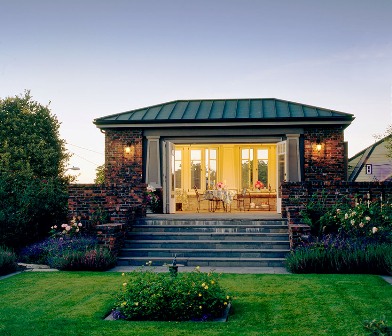A beautiful brick dining pavilion inspired by a royal “Orangery”
December 21st, 2008
A modern-day dining pavilion, rooted in history [William Wright photograph]
This stately dining pavilion is the setting for the best garden parties. Start with impromptu dinner invitations for a few friends, add a bottle of wine, ripe tomatoes and bunches of basil harvested fresh from the garden. Joan Enticknap’s al fresco destination infuses her events with a carefree spirit. After dinner, guests usually wander off and enjoy her garden.
Bill Wright and I were fortunate enough to discover, write about and photograph Joan’s dining pavilion in 2002. She also owns the charming potting shed that graces the cover of our book, Stylish Sheds and Elegant Hideaways, photographed by Bill.
For Joan, a rare double city lot accommodated the construction of a two-car garage at street level. Above it sits her 12-by-22 foot, freestanding dining pavilion.
Designed by Seattle-based Bader Architecture, the inviting structure is connected to her restored 1914 home by a stone terrace. The architects incorporated accordion-fold glass doors across the pavilion’s width, linking it to an herb- and rose-filled garden beyond.
“The open doors allow Joan’s parties to spill out into the garden,” says principal Gregory Bader. Shutters cover 16 pair of windows, each of which opens via tilting or swinging hinges. The windows reinforce the perspective that overlooks the street-scape below and territorial views to the north. In fact, the building is situated perfectly to shelter Joan’s garden from northern winds.
 Project architects Dan Umbach and Andy Salkin drew from local carriage houses and English conservatory influences to create the pavilion. “We loved the orangery at Kensington Palace in England and this really comes from that tradition,” Bader says.
Project architects Dan Umbach and Andy Salkin drew from local carriage houses and English conservatory influences to create the pavilion. “We loved the orangery at Kensington Palace in England and this really comes from that tradition,” Bader says.
Wanting her garage and pavilion to echo the home’s origins, Joan instigated an extensive search for vintage clinker brick.
“I placed ads in (local) newspapers and eventually found a fellow who had saved clinker brick from a Craftsman bungalow.” Seven thousand bricks, combined with the passion of a talented stonemason, constructed the carriage house-inspired pavilion.
When the weather is warm, Joan slides open the pavilion doors and encourages her guests to enjoy seating on the blue stone patio. A wide staircase descends into the fragrant garden below. And that’s when a wonderful meal and beautiful landscape conspire with the senses to lure the party outdoors, any time of day.
A version of this story originally appeared in Seattle Homes and Lifestyles, with text by me and photographs by Bill.
Read further to learn more about The Orangery or L’Orangerie, a new addition to the Shed Glossary.










December 22nd, 2008 at 7:22 am
Beautiful pavillion. That’s definitely the “shed style” I prefer.
Chris Heiler
LandscapeLeadership.com
Follow me on Twitter
December 24th, 2008 at 9:32 am
Something that made me really appreciate our mild SoCal winters was seeing citrus trees potted up and put away in orangeries in Britain.
December 29th, 2008 at 10:56 am
Being a big reader of British novels and nonfiction, I love the idea of orangeries. Wouldn’t we all love to have parties in the one you feature here? What a wonderful dream! Actually, it’s so appealing that I think I could live there, not just dine and party. 🙂
May 21st, 2009 at 5:14 am
Orangeries can add value and interest to your home.In fact, it is possible to enjoy a 100% return on your investment.
August 22nd, 2009 at 4:58 am
Beautiful. The thing with these sort of sheds are ‘looks, or security’ and although i prefer security, i cant ignore the beautiful design of this pavilion.